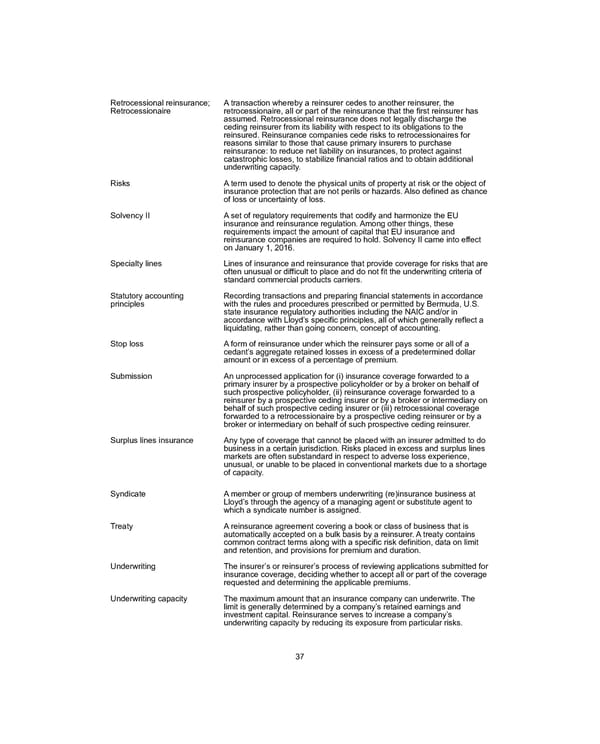Retrocessional reinsurance; Retrocessionaire A transaction whereby a reinsurer cedes to another reinsurer, the retrocessionaire, all or part of the reinsurance that the first reinsurer has assumed. Retrocessional reinsurance does not legally discharge the ceding reinsurer from its liability with respect to its obligations to the reinsured. Reinsurance companies cede risks to retrocessionaires for reasons similar to those that cause primary insurers to purchase reinsurance: to reduce net liability on insurances, to protect against catastrophic losses, to stabilize financial ratios and to obtain additional underwriting capacity. Risks A term used to denote the physical units of property at risk or the object of insurance protection that are not perils or hazards. Also defined as chance of loss or uncertainty of loss. Solvency II A set of regulatory requirements that codify and harmonize the EU insurance and reinsurance regulation. Among other things, these requirements impact the amount of capital that EU insurance and reinsurance companies are required to hold. Solvency II came into effect on January 1, 2016. Specialty lines Lines of insurance and reinsurance that provide coverage for risks that are often unusual or difficult to place and do not fit the underwriting criteria of standard commercial products carriers. Statutory accounting principles Recording transactions and preparing financial statements in accordance with the rules and procedures prescribed or permitted by Bermuda, U.S. state insurance regulatory authorities including the NAIC and/or in accordance with Lloyd’s specific principles, all of which generally reflect a liquidating, rather than going concern, concept of accounting. Stop loss A form of reinsurance under which the reinsurer pays some or all of a cedant’s aggregate retained losses in excess of a predetermined dollar amount or in excess of a percentage of premium. Submission An unprocessed application for (i) insurance coverage forwarded to a primary insurer by a prospective policyholder or by a broker on behalf of such prospective policyholder, (ii) reinsurance coverage forwarded to a reinsurer by a prospective ceding insurer or by a broker or intermediary on behalf of such prospective ceding insurer or (iii) retrocessional coverage forwarded to a retrocessionaire by a prospective ceding reinsurer or by a broker or intermediary on behalf of such prospective ceding reinsurer. Surplus lines insurance Any type of coverage that cannot be placed with an insurer admitted to do business in a certain jurisdiction. Risks placed in excess and surplus lines markets are often substandard in respect to adverse loss experience, unusual, or unable to be placed in conventional markets due to a shortage of capacity. Syndicate A member or group of members underwriting (re)insurance business at Lloyd’s through the agency of a managing agent or substitute agent to which a syndicate number is assigned. Treaty A reinsurance agreement covering a book or class of business that is automatically accepted on a bulk basis by a reinsurer. A treaty contains common contract terms along with a specific risk definition, data on limit and retention, and provisions for premium and duration. Underwriting The insurer’s or reinsurer’s process of reviewing applications submitted for insurance coverage, deciding whether to accept all or part of the coverage requested and determining the applicable premiums. Underwriting capacity The maximum amount that an insurance company can underwrite. The limit is generally determined by a company’s retained earnings and investment capital. Reinsurance serves to increase a company’s underwriting capacity by reducing its exposure from particular risks. 37
 2021 Annual Report Page 52 Page 54
2021 Annual Report Page 52 Page 54